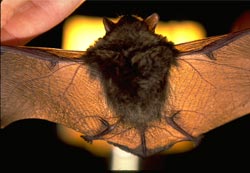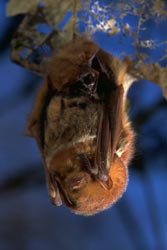Main Content
Article
Bats

Little Brown Bat
Many people think that bats are scary, almost monsters. But, bats are the victims of many bad rumors. They’ve developed an undeserved reputation for sucking blood, carrying rabies and even flying
The body of a bat is a novelty, starting with the fact that it is the only flying mammal on earth. A bat’s wings are actually modified arms. It has four fingers and a thumb on each arm, all within the wing. Each finger has a claw, which is never covered by the wing. Another lesser-known fact about the body structure is that the bat has a tail; it is attached to the inside of the wing.
Bats’ diets range from nectar to birds to insects. Bats in Indiana are insectivorous. One of their best-known hunting methods is echolocation, which allows them to locate insect in flight and also KEEPS them from flying into trees, buildings and, of course people’s hair! While this is a unique and useful skill, bats are not limited to that tactic. The vampire bat, found in South America, is known to tear skin open to lap up blood from the ankles of mammals, primarily farm animals. (None of Indiana’s bats feed in this manner.)

Red Bat
Other species simply find food using their eyesight.
Their eating habits are beneficial to us in many ways. In more tropical areas they assist a great deal with pollination, transferring pollen from plant to plant so reproduction can take place. Because bats can eat up to 50 percent of their body weight in insects, they are responsible for keeping our pest population low. Their fecal material, called guano, is also helpful as a fertilizer and has also been used in gasohol, soaps, and antibiotics.
In short, there is more to these critters than what we give them credit for, and more to learn from them than we can currently imagine. They are amazing creatures with an important role in human society and the natural community.
Want to learn more about bats? Click here to learn about the Indiana bat.
